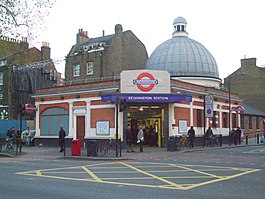Kennington tube station
| Kennington |
|
|---|---|

Station entrance
|
|
|
Location of Kennington in Central London
|
|
| Location | Kennington Park Road |
| Local authority | Southwark |
| Managed by | London Underground |
| Number of platforms | 4 |
| Fare zone | 2 |
| London Underground annual entry and exit | |
| 2012 |
|
| 2013 |
|
| 2014 |
|
| 2015 |
|
| Key dates | |
| 1890 | Opened (C&SLR) |
| 1923 | Closed for reconstruction |
| 1925 | Reopened |
| 1926 | Opened (Charing Cross branch) |
| Other information | |
| Lists of stations | |
| WGS84 | 51°29′19″N 0°06′20″W / 51.48861°N 0.10555°WCoordinates: 51°29′19″N 0°06′20″W / 51.48861°N 0.10555°W |
|
|
|
Kennington is a London Underground station on Kennington Park Road in Kennington on both the Charing Cross and Bank branches of the Northern line. It is within the London Borough of Southwark. Its neighbouring stations to the north are Waterloo on the Charing Cross branch and Elephant & Castle on the Bank branch; the next station to the south is Oval. The station is in Travelcard Zone 2.
The station was opened on 18 December 1890 as part of London's first deep-level tube, the City & South London Railway (C&SLR) (now the Bank branch of the Northern line). The name 'Kennington' was adopted instead of 'Kennington Park Road' although in fact it was in the civil parish of Newington and thence became part of Southwark rather than in the Kennington part of Lambeth. The layout was originally similar to the current arrangement at Borough, with one platform (the northbound) having level access to the lift, and the other (the southbound) being one floor below it.
Two extra platforms were added in 1926, when the connection via Waterloo to Embankment on the former Charing Cross, Euston & Hampstead Railway (now the Charing Cross branch) was built. At that time the old northbound platform was reconstructed, so that the track runs down the other side of the tunnel (to allow cross-platform interchange), resulting in unusually large tunnel mouths; this also produced an apparently mysterious door in the wall opposite the platform - the original access to the platform is concealed behind the door.
...
Wikipedia

